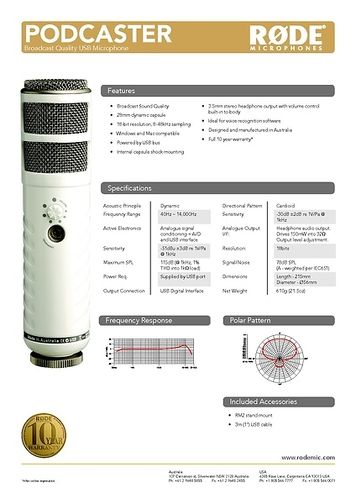
But it's quite possible that the combination of the internal pop filter and the use of a dynamic capsule is the reason for the clean-but-controlled signal. I can attest that, as long as you set a solid signal, the mic seems to stave off most peaks from distorting, almost as if there's some built-in compression like you hear with mics that employ DSP in the signal chain. While there is no DSP, Rode uses "analog signal conditioning," a somewhat vague term. In short, it sounds a lot like a talk radio DJ's mic, with a professional, controlled, and somewhat rich signal. The internal pop filter really does some work-it sounds like the signal is coming through a windscreen.

I found that, from a distance of roughly four to five inches, it offers a solid, clear signal that sounds a bit less crisp and somewhat softer than some of the other mics I've tested. I recorded with the Podcaster on a Mac Pro in GarageBand, which recognized the mic immediately. If your home studio rattles when the subway trains rumble below your apartment, an actual shock mount might be necessary. I don't feel the mic is missing basic stabilization and vibration control that a shock mount would provide, but I was testing it in a stable environment. Of course, the trade-off is a less direct-sounding signal, even when close to the mic.Īnd does the internal shock mount mean that buying an external one is unnecessary? That's more debatable, and it depends on how and where you use the mic. Your best bet, if there's no pop screen or filter available, is to record slightly off-axis-this eliminated plosives during testing for the most part. It's still quite possible to set this capsule off with some plosives. So, does the internal pop filter mean you don't need an external pop filter for unruly or plosive-prone vocals? No. But Rode does manufacture both a windscreen and a shock mount for its mics, should you find either to be necessary. Because Rode includes a pop filter and a shock mount internally, there aren't any accessories like those included, either. You have to adjust the mic's recording levels on your computer instead. The Podcaster is an end-address mic, so the stand you use will need to be sturdy enough to handle its weight when it's angled in the direction of the speaker's mouth.īeyond the stand, an onboard gain knob would be nice. In fact, it might be more likely that USB mic shoppers don't already have stands. If the assumption is that anyone buying a mic already has a stand, well, that's not always going to be the case when someone is purchasing a USB mic. Rode would do well to include a desktop stand, or even integrate a kickstand into the mic itself. What's missing? That's easy: a mic stand. The cardioid-pattern Podcaster's frequency range is from 40Hz to 14kHz, with a fixed 18-bit resolution and a sampling rate range of 8 to 48kHz-you can adjust it in your computer's or software's settings menu. Above the headphone jack, there's a volume knob to dial in ideal zero-latency monitoring levels. The (very long) included USB cable connects to a port on the base of the microphone. (Opens in a new window) Read Our Beyerdynamic Fox ReviewĪn LED on the side panel is thoughtfully located facing the speaker when addressing the mic-it lights up red when the mic signal is peaking, and orange when levels are just below peaking (green is the default color when the mic is receiving power via USB). But the body feels less typical-it has a heavy 1.5-pound build with a glossy white exterior rather than the metallic tones I often see.

The Podcaster comes in a familiar, broadcast-style shape, with a grille wrapping around the top end of the mic. In terms of audio quality, the Rode is a cardioid-pattern mic, with no digital signal processing (DSP), making it a solid choice for radio broadcast-style vocals. And while we've seen 16-bit and 24-bit resolutions thus far, the Podcaster utilizes a less common 18-bit. The other slight surprise is that the Podcaster is a dynamic USB mic, not a condenser mic like many of the competing models. The only irony here is that, at $229, the Rode Podcaster is among the more expensive USB options we've tested.

Thus, its entry into the USB mic realm is a natural progression. Rode is an Australian microphone brand that manufactures good-looking, quality condenser mics for a fraction of the price high-quality models often sell for.

How to Free Up Space on Your iPhone or iPad.How to Block Robotexts and Spam Messages.


 0 kommentar(er)
0 kommentar(er)
